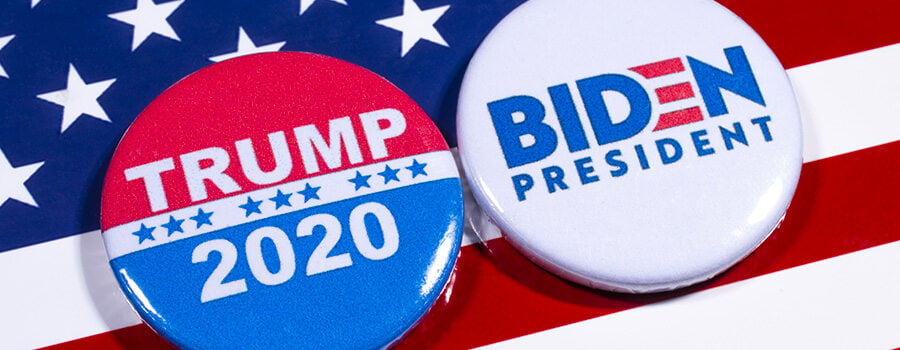With Biden still leading Donald Trump in the polls following yesterday's presidential debate, many things hang in the balance in the run-up to election day, and many questions will need to be resolved before 3 November 2020. But what is the current state of play? And which factors are most likely to affect currency market volatility as Americans go to the ballot boxes?
Volatility in the forex market has been quite low over the past few weeks despite mounting risks related to Brexit, Covid-19 and the US presidential election. However, low volatility might not remain the norm on election day, especially if the election was disputed.
Today, we will discuss the state of play in the US general election, the possible outcomes and their impact on the currency market.
What is the state of play in the US presidential election?
With two weeks remaining until election day and following yesterday’s debate, Biden holds a clear polling lead over incumbent President Trump. However, 2016 demonstrated that surprise outcomes are possible. Given the circumstances (Covid-19 and mail-in ballots), as well as the precedent set by the 2016 election, it is perhaps wise not to pay too much attention to the polls as these are not always reliable. Some pollsters point to the possibility of a Trump victory due to what they call “hidden” Trump voters who shy away from polls. According to CloudResearch, around 11.7% of Trump supporters would not report their true opinions in telephone opinion polls. In contrast, only 5.4% of Democrats are reluctant to share their true voting intentions.
If this phenomenon holds true, it could have a great impact on the outcome of the presidential election. On election night, the market focus will be on the nine states that will determine the White House’s new tenant after 20 January 2021. It will all depend on Michigan, Wisconsin, Iowa, Ohio, Pennsylvania, North Carolina, Georgia, Arizona and Florida. Biden is currently leading in almost of all these, a lead similar to that of Clinton in 2016. And we all know how that turned out…
How did previous presidential campaigns impact the EUR/USD exchange rate?
The greater the uncertainty regarding the outcome of the vote, the greater the volatility once the winner is announced. This is exactly what happened in November 2016. Volatility increased sharply on 9 November 2016 following reports that Trump had garnered 276 votes in the Electoral College, compared to just 218 votes for Clinton. As a result, the EUR/USD experienced unusually high volatility, with the exchange rate evolving in a range of roughly 200 points, between 1.11 and 1.13, in a single day.
Given the tight 2020 election race, we can easily anticipate similar movements in the EUR/USD, hence the importance of mitigating currency risk to face this period of heightened uncertainty.
What are the potential electoral outcomes and long-term consequences on the EUR/USD?
Market focus is naturally on the presidential showdown, but we should keep in mind that US voters will also be electing new members of Congress.
Here are three possible scenarios for the EUR/USD, depending on the party that wins Congress and enters the White House:
| OUTCOME | PROBABILITY | ECONOMIC POLICY | ESTIMATED IMPACT ON THE FOREX MARKET AND THE FED |
|---|---|---|---|
| Biden wins, both chambers of the US Congress go to the Democrats. | 40% |
|
|
| Trump wins, divided US Congress. | 40% |
|
|
| Biden wins, divided US Congress. | 20% |
|
|
The market is currently pricing in a Democratic sweep (Biden wins, both chambers of the US Congress go to the Democrats). Any variation come election day may well inject short-term volatility.
What happens if there is a contested election?
In the event of irregularities in the electoral process, anticipated by some political analysts due to unprecedented numbers of mail-in votes, the winner’s name may not be known on the night of 3 November. Depending on the judicial process initiated, it might take days or even weeks before the name of the new US president is announced. Ultimately, the Supreme Court, with a conservative majority, may be called upon to decide and declare the name of president-elect.
This doomsday scenario, if it materialises, would lead to a strong increase in risk aversion and volatility on the foreign exchange market. As this has never occurred in recent history, it is difficult to assess the possible impact on the US dollar. In our view, the best way to mitigate this risk is to turn to the Japanese yen, which should perform well in case of a disputed election due to its intrinsic safe-haven status.
Election timeline
| DATE | EVENT |
| 3 November | Election day. |
| 4-5 November | FOMC meeting. Status quo expected, but Powell could express concerns about downside risks to growth, related to Covid-19 spread. |
| 8 December | “Safe harbor” deadline by which states must resolve any controversy regarding election disputes. |
| 14 December | Members of the Electoral College cast their ballots for president. The candidate receiving a majority of the 538 electoral votes becomes the new president. |
| 23 December | Deadline for states to submit their votes to Congress. |
| 6 January 2021 | The US Congress gathers to count the electoral votes and declare a winner. |
| 20 January 2021 | Inauguration day. |
Topics






